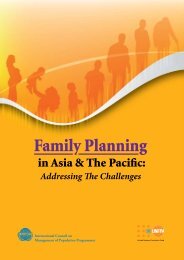Timor Leste CEDAW Specific Report on Education and Health Sectors
Timor Leste CEDAW Specific Report on Education and Health Sectors
Timor Leste CEDAW Specific Report on Education and Health Sectors
Create successful ePaper yourself
Turn your PDF publications into a flip-book with our unique Google optimized e-Paper software.
<strong>and</strong> informati<strong>on</strong> to young people, those in-school <strong>and</strong> out-of-school, <strong>and</strong> especially hardto-reachadolescents <strong>and</strong> youth.Maternal, Child <strong>and</strong> Infant Mortality49. <str<strong>on</strong>g>Timor</str<strong>on</strong>g>-<str<strong>on</strong>g>Leste</str<strong>on</strong>g> is committed to improve maternal <strong>and</strong> child health as stated in the <str<strong>on</strong>g>Timor</str<strong>on</strong>g>-<str<strong>on</strong>g>Leste</str<strong>on</strong>g> Strategic Development Plan (SDP) 2011-2030 37 <strong>and</strong> the Nati<strong>on</strong>al <strong>Health</strong> StrategicPlan (NHSP) 2011-2030 38 . The Integrated Management of Childhood Illness (IMCI)program has already enabled steady progress in child health care <strong>and</strong> good improvementin infant mortality rate. There has been an increase in assisted deliveries from 19% 39 in2003 to an average of 29.9% 40 reported in 2009-10 <strong>and</strong> there has been a stable decrease<strong>on</strong> maternal mortality rate (MMR) from the baseline estimate of 660 in 2000 to 557 in2009-10. 41 Nevertheless, it is important to point out that the MMR for <str<strong>on</strong>g>Timor</str<strong>on</strong>g>-<str<strong>on</strong>g>Leste</str<strong>on</strong>g>remains <strong>on</strong>e of the highest in the world, where 42% of all deaths of women aged 15-49are related to pregnancy. To reach the 2015 Millennium Development Goal (MDG) of252 maternal deaths for every 100,000 live births, the current rate would have to benearly cut in half. C<strong>on</strong>tributing factors to the high maternal mortality rate include: <strong>on</strong>ly30% of all births are delivered by a doctor, nurse or midwife; the current fertility rate of5.7, is still high, although it has dropped from 7.8. And finally, many <str<strong>on</strong>g>Timor</str<strong>on</strong>g>ese womenare c<strong>on</strong>sidered too thin, 27% have a Body Mass Index (BMI) of less than 18.5; <strong>and</strong> many<str<strong>on</strong>g>Timor</str<strong>on</strong>g>ese women also suffer from anemia, 21%. 42 Increased efforts to address highmaternal mortality are of utmost need, particularly in the area of increased resourcestowards ANC for pregnant women <strong>and</strong> skilled birth attendance.50. There has been a general decline in infant <strong>and</strong> child mortality. The infant mortality ratehas decreased from 60 per 1,000 in 2003, to 45 per 1,000 in 2009/10, <strong>and</strong> a reducti<strong>on</strong> inthe under-5 mortality from 83 per 1,000 in 1999-2003, to 64 per 1,000 during 2005-2009. 43 <str<strong>on</strong>g>Timor</str<strong>on</strong>g>-<str<strong>on</strong>g>Leste</str<strong>on</strong>g> is c<strong>on</strong>sidered <strong>on</strong>-track to meet its MDG Goal to reduce under-5mortality by two-thirds by 2015.Research <strong>on</strong> the Root Causes of Maternal <strong>and</strong> Child Mortality51. The Ministry of <strong>Health</strong> (MoH) formally opened the Cabinet of <strong>Health</strong> Research <strong>and</strong>Development in January 2010. Its aim is to organise, promote, facilitate <strong>and</strong> c<strong>on</strong>ducthealth research in <str<strong>on</strong>g>Timor</str<strong>on</strong>g>-<str<strong>on</strong>g>Leste</str<strong>on</strong>g>. As part of the Cabinet there is a Technical <strong>and</strong> Ethical37 Government of <str<strong>on</strong>g>Timor</str<strong>on</strong>g>--<str<strong>on</strong>g>Leste</str<strong>on</strong>g> Strategic Development Plan (SDP) 2011--<str<strong>on</strong>g>Leste</str<strong>on</strong>g>. Pg. 3938 Nati<strong>on</strong>al <strong>Health</strong> Strategic Plan (NHSP) 2011-July 2010), Sec. 2, 20 Years Visi<strong>on</strong>, Dili, <str<strong>on</strong>g>Timor</str<strong>on</strong>g>-<str<strong>on</strong>g>Leste</str<strong>on</strong>g>, Pg. 2239 DHS 2003, Pg. 940 DHS 2009-10, Pg 12141 UNDP <strong>and</strong> the Government of <str<strong>on</strong>g>Timor</str<strong>on</strong>g>-<str<strong>on</strong>g>Leste</str<strong>on</strong>g>, 2009, qtd -<str<strong>on</strong>g>Leste</str<strong>on</strong>g>Demographic <strong>and</strong> <strong>Health</strong> Survey (DHS) 2009-10 (Nov 2010), Dili, <str<strong>on</strong>g>Timor</str<strong>on</strong>g>-<str<strong>on</strong>g>Leste</str<strong>on</strong>g>, Pg. 10942 DHS -10 TLDHS is the first direct measure of maternal mortality because it is based <strong>on</strong>survey data <strong>and</strong> is therefore not comparable to other model-based estimates of MMR that have been used in <str<strong>on</strong>g>Timor</str<strong>on</strong>g>-<str<strong>on</strong>g>Leste</str<strong>on</strong>g> in Pg. 11243 DHS 2009-10, Pg. 10112 | <str<strong>on</strong>g>CEDAW</str<strong>on</strong>g> <str<strong>on</strong>g>Specific</str<strong>on</strong>g> <str<strong>on</strong>g>Report</str<strong>on</strong>g> <strong>on</strong> Educati<strong>on</strong> <strong>and</strong> <strong>Health</strong> <strong>Sectors</strong> <str<strong>on</strong>g>Timor</str<strong>on</strong>g>-<str<strong>on</strong>g>Leste</str<strong>on</strong>g>














